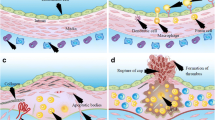Abstract
The artery wall responds to changes in wall shear stress or tensile stress with modeling reactions which assure wall stability and continued adequate flow. The intima participates in these reactions and the adaptive processes continue during atherogenesis. The lumen tends to remain circular and the lesion is sequestered from the lumen by a fibrous cap. The artery enlarges, tending to preserve an adequate lumen cross-sectional area. Since lesions form initially in regions of low wall shear stress, early detection by methods such as ultrasonography must take into account circumferential and axial plaque distribution in relation to flow patterns. For the carotid bifurcation, for example, flow and maximum intimal thickening follow a helical path from the near wall at the distal common carotid artery to the far wall at the bifurcation and in the proximal internal carotid. Large plaques are complex with juxtaposition of regions of different composition and complex lesions tend to become complicated by disruption, thrombosis and plaque hemorrhage. Features which suggest manifest or imminent plaque disruption include thinning, absence or erosion of the fibrous cap in apposition to lipid pools or calcifications, and lumen irregularities or cavitations. Regions of contrasting density and/or extensive regions of low density, particularly in large plaques suggest vulnerability to disruption. Disruption of plaques are associated with hemodynamic stresses and plaque strains associated with marked stenosis, elevated heart rate and rapid excursions of pressure.
Similar content being viewed by others
References
Glagov S, Zarins CK. Quantitating atherosclerosis: Problems of Definition, Chapter 2. In: Clinical Diagnosis of Atherosclerosis; Quantitative Methods of Evaluations (eds. MG Bond, W Insull, S Glagov, AB Chandler, F Cornhill) (1983) p 11, Springer-Verlag, New York.
Glagov S, Weisenberg E, Zarins CK, Stankunavicius R, Kolettis G. Compensatory enlargement of human atherosclerotic coronary arteries. N Engl J Med 316 (1987): 1371–5.
Zarins CK, Weisenberg E, Kolettis G, Stankunavicius R, Glagov S. Differential enlargement of artery segments in response to enlarging atherosclerotic plaques. J Vasc Surg 7 (1988): 386–94.
Ko C, Glagov S, Zarins CK. Structural basis for the compensatory enlargement of arteries during early atherogenesis. Proceedings of the 3rd International Workshop on Vascular Hemodynamics (Bologna, 1991) (ed E Borgatti, Centra Scientifico Editore) (1992): 157–61.
Masawa N, Glagov S, Zarins CK. Quantitative morphologic study of intimal thickening at the human carotid bifurcation: II. The compensatory enlargement response and the role of the intima in tensile support. Atherosclerosis 107 (1994): 147–55.
Glagov S, Zarins CK, Masawa N, Xu CP, Bassiouny H, Giddens DP. Mechanical functional role of non-atherosclerotic intimal thickening. Frontier Med Biol Engng 5 (1993): 37–43.
Glagov S. Intimal hyperplasia, vascular modeling and the restenosis problem. Circulation 89 (1994): 2888–91.
Tang R, Mercuri M, Bond MG. B-mode ultrasound imaging for detecting and monitoring peripheral atherosclerosis. Am J Cardiac Imaging 6 (1992): 333.
Masawa N, Glagov S, Zarins CK. Quantitative morphologic study of intimal thickening at the human carotid bifurcation. I. Axial and circumferential distribution of maximum intimal thickening in asymptomatic and uncomplicated plaques. Atherosclerosis 107 (1994): 137–46.
Ku DN, Giddens DP. Pulsatile flow in a model carotid bifurcation. Arteriosclerosis 3 (1983): 31–9.
Bomberger RA, Zarins CK, Glagov S. Subcritical arterial stenosis enhances distal atherosclerosis. J Surg Res 30 (1981): 205–12.
Bassiouny HS, Davis H, Masawa N, Gewertz BL, Glagov S, Zarins CK. Critical carotid stenosis: Morphological and chemical similarity between symptomatic and asymptomatic plaques. J Vasc Surg 9 (1989): 202–12.
Author information
Authors and Affiliations
Rights and permissions
About this article
Cite this article
Glagov, S., Masawa, N., Bassiouny, H. et al. Morphologic bases for establishing end-points for early plaque detection and plaque instability. Int J Cardiac Imag 11 (Suppl 2), 97–103 (1995). https://doi.org/10.1007/BF01419821
Accepted:
Issue Date:
DOI: https://doi.org/10.1007/BF01419821




